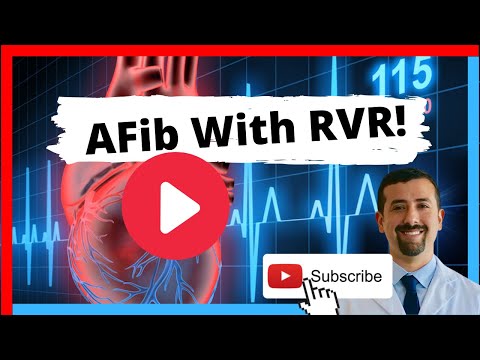When it comes to heart health, we can’t afford to ignore conditions like afib with RVR. Atrial fibrillation (afib) is a common heart rhythm disorder that drastically messes with your heartbeat’s coordination. Throw in a rapid ventricular response (RVR), and you’ve got a condition that demands our full attention. So, let’s dive deep into what afib with RVR means, its prevalence, and why it’s so important to distinguish it from simple afib.
Afib alone isn’t just a harmless flutter; it can lead to intense complications. When accompanied by RVR, the potential for major issues skyrockets. We’re talking about a keen increase in symptoms, which can lead to conditions like heart failure or even stroke. And trust me, we don’t want to go there! Understanding the nuances of afib with RVR can help individuals, healthcare providers, and families better prepare for its potential risks and impacts.

Top 5 Risks of Afib with Rvr You Need to Know
Alright, folks, let’s get serious . Here are five critical risks of afib with RVR every single person should know:
1. Stroke
People living with afib already face about a five-fold increased risk of stroke. When RVR enters the scene? That risk climbs even higher. This is mainly due to the irregular heart rhythms, increasing potential for blood clots. Don’t gamble with what might happen; stay informed!
2. Heart Failure
Rapid ventricular response isn’t just uncomfortable; it can worsen underlying heart problems. When the heart’s rhythm goes haywire, it can really mess with how the heart fills up blood during diastole. We’re talking about decreased cardiac output and a world of trouble.
3. Increased Hospitalization
If you’re constantly feeling palpitations or chest pain, chances are you’ll end up in the emergency room more often. The reality is that afib with RVR leads to higher hospitalization rates, disrupting your life in ways you don’t want.
4. Impaired Quality of Life
Imagine battling chronic fatigue or breathlessness. Sounds awful, right? That’s the daily grind for many with afib and RVR, damaging your quality of life and even affecting how you tackle your fitness goals.
5. Associated Comorbidities
Let’s not forget that afib with RVR can often go hand-in-hand with other conditions like hypertension and diabetes. These comorbidities complicate treatment and can greatly affect how you manage your overall health. Taking a holistic approach becomes vital in this scenario.

Treatment Options: A Multi-faceted Approach
When facing something as intimidating as afib with RVR, a multi-faceted treatment strategy becomes essential. Here’s what can work:
1. Rate Control
Consider medications such as beta-blockers (like Metoprolol) and calcium channel blockers (like Diltiazem). These help keep your heart rate manageable during RVR episodes. It’s about keeping things steady!
2. Rhythm Control
Antiarrhythmic drugs like Flecainide and Amiodarone might be in the mix to bring that normal rhythm back. In persistent cases, catheter ablation could also save the day. It’s all about finding what keeps your heart ticking smoothly.
3. Anticoagulation Therapy
Warfarin or newer options like NOACs (e.g., Apixaban) can reduce the chances of stroke. Patients grappling with afib with RVR would greatly benefit from this kind of preventive strategy.
4. Lifestyle Modifications
Start small! Reducing caffeine, managing stress, and engaging in moderate exercise can help you feel much better. You want to put your best foot forward, and these changes can help you along the way!
5. Comprehensive Care Coordination
Taking a holistic outlook means not just focusing on the heart but also areas like nutritional support and dental health. Insurance providers like Aetna Dental have options available that promote better health outcomes. Being well-rounded is pivotal.

The Intersection of Medications: Afib with Rvr, Panacur, and Demodex Treatment
Interestingly, while afib with RVR mainly pertains to heart health, other medications come into the spotlight. Take Panacur, typically used for treating parasitic infections. Though not directly linked, some speculate about its anti-inflammatory properties. In cases where Demodex—those pesky little skin mites—intersect with RVR due to stress or declining health, understanding the full scope of patient wellness becomes immensely vital.
Managing your health isn’t just about the heart; it’s also your skin and overall wellness. You never know how interconnected your body’s systems can be.

Path Forward: Innovative Strategies for Patients and Healthcare Providers
As we look ahead, it’s clear that managing afib with RVR requires an integrated approach. Here are some strategies to keep in mind:
1. Emphasizing Technology in Monitoring
Wearable ECG monitors can be game-changers. They offer real-time heart rhythm data, enabling both patients and healthcare providers to tackle afib with RVR proactively.
2. Growth in Educational Outreach
Education is key! Expanding programs on afib with RVR awareness and preventive steps can drastically improve patient outcomes. This is where collaboration with providers, including dental health consultations facilitated by companies like Aetna, fits in.
Conclusion: A Call to Action
If there’s one thing to walk away with, it’s this: The complexity of afib with RVR demands our attention! We need to be proactive and informed. With the right knowledge, monitoring, and lifestyle adjustments, we can dramatically improve our quality of life while combating the risks this condition brings.
Let’s commit to a brighter, healthier future—one where we conquer heart challenges instead of letting them conquer us. Your heart deserves the best!

Understanding afib with rvr: Fun Facts and Trivia
What’s the Buzz About afib with rvr?
Did you know that afib with rvr, or atrial fibrillation with rapid ventricular response, can affect the heart’s rhythm significantly? This condition causes the heart to beat faster than normal, sometimes exceeding 100 beats per minute! Speaking of beats, planning to catch a game can be pretty thrilling too—like wondering What time do The Lions play today?( Just as you wouldn’t want to miss that game, folks with afib need to keep an eye on their heart rhythm.
Interestingly, while we’re talking about health, some medications, like Nurtec Odt,(,) can sometimes influence the heart’s pace. Patients must be cautious about drug interactions, as they can lead to uncomfortable spikes in heart rate. If you dive into lifestyle choices, like whether to hit up one of those stunning Aspen Colorado Resorts,(,) you might find that activities can have a dramatic impact on overall health, including heart rhythm!
Health Risk Gotcha!
One fun fact about afib with rvr is that it affects millions worldwide, making awareness a serious topic. With that, it’s essential to understand the symptoms which can sometimes sneak up on you, just like a classic twist in one of those Movies To watch( when you least expect it!
And let’s not forget about the social angle. Living with afib can be challenging, impacting relationships and overall mood. Comparatively, consider the cultural impact of figures like Lisa Left eye lopes,(,) who overcame her own struggles while sharing insights into health and wellness. Every experience brings knowledge and awareness—similar to how becoming Agender() can shape one’s identity in meaningful ways.
So, as you learn about afib with rvr, think about how the interplay of health, culture, and choices affects everyone around us. We make decisions based on how our heart feels—quite literally! And while diving deeper into health matters, it can be easier to digest if you think about nutrition. For instance, did you know that amino acids like alanine( play a role in heart health? So many elements intertwine, making it clear that health is as thrilling as the latest blockbuster!



























